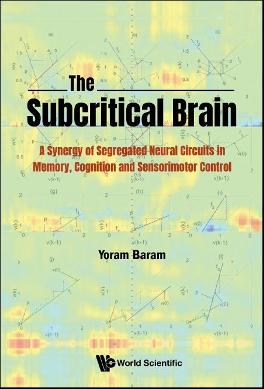‘A must read for anyone interested in theoretical studies of cortical microcircuits’
What is perhaps the most wonderous and fascinating creation of nature, the brain, attracting, on one level or another, over centuries, human curiosity, becomes a welcoming territory to be explored from a fresh new perspective of mathematical and cortical synergies in Prof. Yoram Baram’s latest publication.
Have over a hundred years of brain research revealed all its secrets? An incredibly large body of knowledge and understanding of brain and mind does not seem to have eliminated the sense of a missing link connecting it all. The Subcritical Brain: A Synergy of Segregated Neural Circuits in Memory, Cognition and Sensorimotor Control was motivated by a realization that it is the synergy of certain mathematical concepts that holds the key to a more comprehensive and complete understanding of cortical function and behavior.
The first question which might follow such a claim is “why would we turn to advanced mathematics, when there are all these experimental findings on cortical function and behavior?” The answer is that experimental research, by nature, requires a high degree of specificity. Consequently, seemingly separate issues, such as cortical development, inter-neuron connectivity, neuronal firing dynamics, learning, memory and medical condition, have been experimentally studied in essentially complete mutual isolation. On the other hand, mathematical analysis, characterized by absolute formality and accuracy, can, subject to parameterization, apply to neural circuits of different characteristics and functions, so as to simultaneously reveal small and large-scale cortical activities resulting in a large variety of outcomes.
A particularly notable conclusion of this book is that small neural circuits are more efficient than large circuits, providing decisively higher information storage and processing capacities. Shown to be a joint consequence of the theories of random graphs, prime numbers, dynamical systems and quantum computation, the small-circuit paradigm is linguistically consistent with the short-word limitation underlying both natural and artificial (e.g., computer) languages. Small circuits are shown to define primal-size categories, which explain experimental psychological tests of “working memory”. Trees of such circuits are shown to facilitate maximum-length non-repetitious meta-periodic firing, holding the key to memory of large-scale scenic, spoken, written and musical items. Beyond these discoveries, the book systematically addresses the relationships between firing-rate dynamics and developmental stages, on the one hand, and such attributes as symmetry, asymmetry, synchrony and asynchrony in cortical functions, on the other. The clinically tested effects of the underlying mathematical concepts on sensorimotor control in healthy as well as neurologically impaired humans are presented, along with basic mathematically-implied movement strategies in such beings as birds.
###
The Subcritical Brain: A Synergy of Segregated Neural Circuits in Memory, Cognition and Sensorimotor Control retails for US$98 / £85 (hardcover) and is also available in electronic formats. To order or know more about the book, visit http://www.
About the Author
Professor Yoram Baram of the Computer Science department at the Technion received the BSc degree in Aeronautical Engineering from the Technion in 1972, the MSc degree in Aeronautics and Astronautics from MIT in 1974, and the PhD degree in Electrical Engineering and Computer Science from MIT in 1976. Specializing in control theory, he spent the next twenty years investigating and teaching system dynamics in Israel and in the US, including two sabbatical terms as a Senior Research Associate of the National Research Council at the NASA Ames Research Centre, where he also served as a consultant in 1986-2006. In 1999-2004 he developed a virtual reality apparatus for gait improvement in neurological patients, for which he was awarded a US patent. In 2005 he received the Research Award for Best Platform Presentation in the conference on multiple sclerosis CMSC. In 2006 he was appointed the incumbent of the Technion’s Roy Mattas/Winnipeg Chair in Biomedical Engineering. The effectiveness of the sensory feedback device in the improvement of gait in adults and in children with neurological disorders was clinically tested and published in leading medical journals during 2002-2016. Professor Baram has supervised about thirty graduate students. In recent years he has been working on a mathematical theory of dynamics and information coding in neurobiological systems, and serving as head of the Technion Centre for Research in Intelligent Systems. Having retired in 2015, he maintains a full research schedule at the Technion, publishing his work in leading neuroscience journals.
About World Scientific Publishing Co.
World Scientific Publishing is a leading international independent publisher of books and journals for the scholarly, research and professional communities. World Scientific collaborates with prestigious organisations like the Nobel Foundation and US National Academies Press to bring high quality academic and professional content to researchers and academics worldwide. The company publishes about 600 books and over 140 journals in various fields annually. To find out more about World Scientific, please visit http://www.
For more information, contact Jason Lim at [email protected].
Media Contact
Jason Lim
[email protected]
Original Source
https:/





